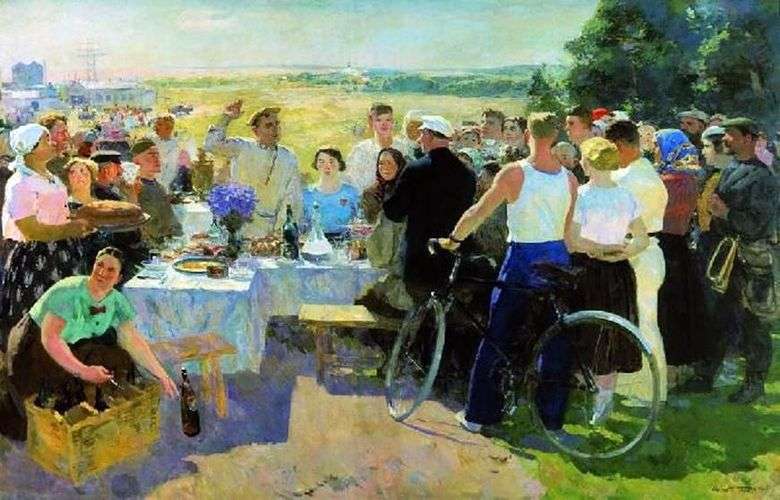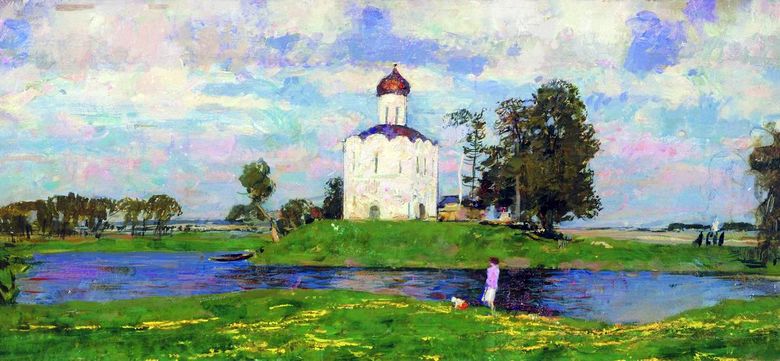
It is characteristic that the artist went to the creation of this canvas for a long time by accumulating many years of material, by familiarizing himself with the present, with the knowledge of its particular structure in the many etudes of village life. For the first time, the “Kolkhoz Holiday” appeared before the audience at the exhibition “Industry of Socialism” in 1938. Immediately a fierce debate broke out around the canvas; not everything was understood and accepted in the picture at once. There were voices that reproached the artist for not sufficiently revealing the topic, but that the artist pays too much attention to the image of nature, that the content is more vividly expressed in the landscape… It took a lot of time for the picture to occupy a well-deserved place among the best works of Soviet painting.
The picture is permeated with a joyous attitude, which is so characteristic of Soviet people of that time. People worked hard, every new day brought the generous fruits of these labors. The people lived with a sense of happiness, joy, it seemed, a bright road of work, accomplishments and victories there are no barriers. Gerasimov was able to catch this in the expression of the faces of his heroes, in their habits, in the free ease of movements. It is felt right away, although the artist shows in the midst of merriment, when people, flushed with food and drink, would start dancing, burst into song, and the very beginning of the holiday. The crowd crowded at the richly laid tables is calm. Seriously listen to people, maybe, and not too deft, but the hot and excited speech of the chairman.
To admit, with some surprise note, looking at the picture, that there is not one that is not that laughing, but even smiling face. Where does this feeling of light joy, some gaiety of the soul, which infects you at first sight? Here “wine” is the richest painting skill of Gerasimov. Generous sun floods the whole scene. Light rays fall on the faces, play in juicy greens, crushing, shimmer in the edges of the glass, give each color, any object a transparent lightness, airiness. It is masterfully transformed light saturates the canvas with such a thin variety of color shades. Light gives the white tablecloth a blue tint, different white shirts, blouses, shawls with a complex combination of warm pink, yellowish, lilac, cold blue and green reflexes. This white color,
Transparent lilac shadows on pink sand, blind eyes glare on freshly scraped wooden benches. The beats of open blue, bright red sounded sonorous among these thin tonal transitions. Paints in the neighborhood with each other, in combination, sometimes in sharp contrast contrast, become more intense, more intense. On the blue dress of that young girl that sits on the left of the chairman, the red badge seems especially bright. A dark red bow on the blouse of a woman taking bottles out of the basket tells the green color of the blouse a special clarity and certainty. And so in any piece of the canvas: the color combinations are thought out very carefully, as though accurately “played” according to the “color score” composed by the artist.
Gerasimov shows how powerful expressiveness is in color, if you manage to subordinate his thoughts, if you manage to bring it into line with the idea, with the system of feelings that you strive to express. It turns out that such a great humanistic idea as the affirmation of life can be expressed in a picturesque system, in the sunshine, in the airiness of the landscape. By the way, nature plays one of the main roles in the film. The whole scene is masterfully connected with the landscape. Figures of people are closely grouped in the foreground, and there, right behind their backs, the wide expanse of a green field spreads wide. The view glides smoothly along it, to where the thin blue stripe divides, simultaneously joins the sky to the ground.
Near the horizon are blue hills. The artist does not resort to a catchy, beautiful landscape motif – a bare field, hills in the distance and a cluster of bright green, in the juicy foliage of trees… But something infinitely native, the Russians are blowing from this expanse. Feeling sharply national in the appearance and perception of nature is characteristic of the entire landscape creativity of Gerasimov. For an artist, the landscape is not just a topic close to the heart. Here the personality, the nature of the artist, the feelings of the citizen of his land find an unusually full expression. Nature in his perception is full of poetic charm, special lyricism. Any, the smallest etude is marked by the author’s characteristic color solutions, a picturesque manner. Over the years, the landscape art of Gerasimov has undergone significant changes. The works of the 1920s were distinguished by color restraint, almost monochrome, severity of figurative decisions, the monumentality of the compositional system. Already by the beginning of the 1930s – and the farther, the more generous-in the pictures appear clear sun, light, joyful wealth of color.
The artist completely refuses exaltation in the manifestation of feelings, from violent gesticulation. His characters have so that the hands of most people are either hidden behind the figures of neighbors, or on the edge of the table. And those few pairs of hands that “act” in the picture, or calmly folded, like this girl standing on the right, or “tied” to a case – take out bottles, hold a dish with a festive pie, lean on a bicycle. It tells the silhouette of the whole and to each figure and the whole scene in general.
In this restraint, a special role is played by the energetic gesture of the speaker, making his image central, leading in action. The composition is built bas-relief, on a narrow foreground strip. The artist has his heroes on the hillock, and it is this trick that gives him the opportunity to unfold before our eyes a wide panorama, far from the top. The art of Gerasimov is captivated by the reflection of vivid paintings and the very essence of modern life, poetic heat, great pictorial culture. And yet, most of all, it is strong that it is deep, truly national.
 Church of the Intercession on the Nerl by Sergei Gerasimov
Church of the Intercession on the Nerl by Sergei Gerasimov Vacaciones de Kolkhoz – Sergey Gerasimov
Vacaciones de Kolkhoz – Sergey Gerasimov Partisan’s mother by Sergey Gerasimov
Partisan’s mother by Sergey Gerasimov After the rain (Wet Terrace) by Alexander Gerasimov
After the rain (Wet Terrace) by Alexander Gerasimov Gifts of Autumn by Alexander Gerasimov
Gifts of Autumn by Alexander Gerasimov Langlois Bridge in Arles and erasing women by Vincent Van Gogh
Langlois Bridge in Arles and erasing women by Vincent Van Gogh Église de l’Intercession sur la Nerl – Sergey Gerasimov
Église de l’Intercession sur la Nerl – Sergey Gerasimov Still life. Wildflowers by Alexander Gerasimov
Still life. Wildflowers by Alexander Gerasimov